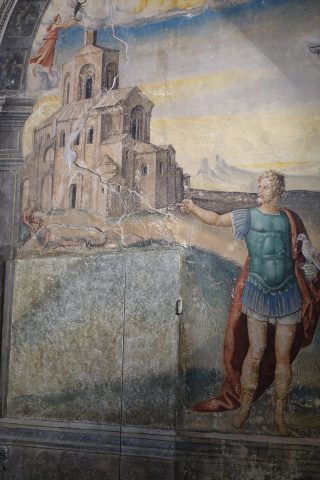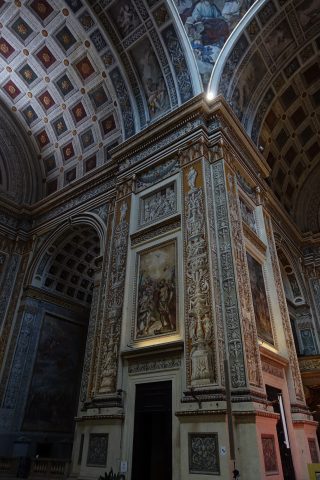Mantua Italian capital of culture 2016: even Mantegna would be proud of it
- Mantova from above, courtesy of Roberto Merlo and Archivio Comune di Mantova.
- Falconetto Giovanni Maria, Hall of the Zodiac, 1520, Mantua, Palazzo d’Arco.
- Falconetto Giovanni Maria, Hall of the Zodiac, 1520, Mantua, Palazzo d’Arco.
- Falconetto Giovanni Maria, Hall of the Zodiac, 1520, Mantua, Palazzo d’Arco.
- Falconetto Giovanni Maria, Hall of the Zodiac, 1520, Mantua, Palazzo d’Arco.
- Falconetto Giovanni Maria, Hall of the Zodiac, 1520, Mantua, Palazzo d’Arco.
- Giovanna d’Arco Marchesa Guidi di Bagno (1880-1973).
- St. Andrew’s Church, Mantua.
- St. Andrew’s Church, Mantua.
- Scientific Theatre Bibiena, Mantua.
- Scientific Theatre Bibiena, Mantua.
Since April Mantua has officially started its year as the Italian Capital of Culture 2016, a recognition that was appointed in late October 2015 and will last the whole year. Despite the short period of time between the designation and the actual beginning of the project, Mantua has seriously taken up the challenge and we must say, after a visit, it is living up to the expectations. The title “Italian Capital of Culture” was introduced in December 2014 , following the successful process of selection which saw involved six Italian cities to become Europe Capital of Culture 2019 (eventually won by Matera). Considering the positive effects that resulted from this race, the MIBAC (the Italian Ministero dei Beni e delle Attività Culturali e del Turismo) decided to appoint the five cities left out to be the Italian Capitals of Culture 2015 (Cagliari, Lecce, Perugia, Ravenna and Siena). Hence, this is the first time that a single city was chosen to cover the title, and Mantua stood out, not only for the rich history and its artistic and cultural legacy from the past, but also for its projects which look at the future. As stated in the press release “Without forgetting the past, Mantua wants to renovate as a centre of ideas to accommodate contemporary creativity”.
The city has received €1 million from the Ministry of culture, which together with the other funds the city has been collecting will contribute to cover the €16 million expenses planned for the many important restoration works of Mantua’s cultural and architectural heritage, including Palazzo del Podestà, Torre della Gabbia and Rocca di Sparafucile. Amongst other projects that have recently taken place in the city, we would like to mention the reopening of Palazzo D’Arco to the public, after two years of works aimed both at the restoration and at the renovation in compliance with safety regulations. The project, which apparently amounted to €1 million was led by Fondazione d’Arco, the actual owner of the namesake palace which, as stated by the architect Silvia Polato who directed the work, was studied in its totality with the ultimate goal not only to offer new exhibition itinerary to the visitors but also to host cultural events, literary salons and conferences. There will also be atelier dedicated to family and workshops for children.
Undoubtedly the palace is a charming and inspiring dwelling, the only one in Mantua still entirely decorated with original furniture which was transformed into a museum in 1980, according to the will of Giovanna d’Arco Marchesa Guidi di Bagno, the last heir of the D’Arco family (the Italian branch) who inhabited the palace until her death in 1973. And indeed when you walk around the rooms you have that cozy feeling as if there were people still living there. Renovated in 1784 by the neoclassical architect Antonio Colonna, the d’Arco’s properties was then expanded in 1873 with the addition of two renaissance buildings – acquired from the Dalla Valle’s family – which are located in the garden, past the elegant neoclassic exedra.
The first edifice you come across on the right, hosts on the upper floor the Hall of the Zodiac, a room entirely decorated with a cycle of frescos illustrating the zodiac through personifications, myths and legends which was attributed at the beginning of the 20th century by the art historian Fiocco to the Veronese painter Giovanni Maria Falconetto. In the scholar’s opinion, the work was executed around 1520. The artist painted a classic loggia divided into twelve frames, each one dedicated to a sign of the zodiac, following a scheme which was applied very similarly to almost all the signs. The frescoes have been conserved extremely well, except for the arch dedicated to the Libra at the end of the hall which was covered by a fireplace most likely during the 17th century and it went lost (in case this is your sign and you find it difficult to spot on the walls).
As stated above, every representation – apparently modeled after Pinturicchio’s frescos in the Domenico della Rovere Palace in Rome whose own literary source can be pinpointed in the XIIth century Byzantine novel by Eustathios (o Eumathios) Makrembolites, “Ismine e Isminia” – presents similar patterns: the zodiac sign is depicted amongst the clouds, just underneath the keystone, in the foreground it may be easy to discern the various activities of the month, while in the background you can identify classical myths or ancient history events, as well architectures from the Byzantine or Roman period, such as for instance the Arena in Verona (Aries), the Mausoleum of Theodoric (Virgo) or the Church of San Vitale in Ravenna (Gemini and Scorpio).
The room is certainly impressive and has captured the interests not only of art historians, but also of contemporary artists, like Candida Höfer, who a couple of years ago, as part of a project which was eventually put on show at Palazzo Te, took some pictures of the Hall of the Zodiac of Palazzo d’Arco. And again, this is the example of how a beautiful work of the past can revive. This was probably a good prelude for the Italian Capital of Culture 2016, whose success will lie in its ability to move forward, hand in hand with its glorious tradition. And by looking at the website of Palazzo d’Arco, so effective compared to many other Italian museums’ website, even Mantegna would be proud of it.
November 25, 2020











